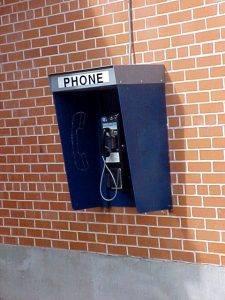 When I was a child people who wanted to talk to someone else either physically went where that person was or picked up a phone and called that person. The phone we used to place the call was either a home phone or a pay phone. In the 1980s it seemed every home had a phone and everywhere that was not a home had a pay phone. It was only when I was a teen in the early 1990s that I moved into the leading edge world of being able to be contacted without a phone. A beeper, however, was not a phone substitute but rather a means of encouraging me to find a phone. As someone not yet in the work force and lacking an office phone, I had to pick up either a home or pay phone to return the call.
When I was a child people who wanted to talk to someone else either physically went where that person was or picked up a phone and called that person. The phone we used to place the call was either a home phone or a pay phone. In the 1980s it seemed every home had a phone and everywhere that was not a home had a pay phone. It was only when I was a teen in the early 1990s that I moved into the leading edge world of being able to be contacted without a phone. A beeper, however, was not a phone substitute but rather a means of encouraging me to find a phone. As someone not yet in the work force and lacking an office phone, I had to pick up either a home or pay phone to return the call.
When it comes to real-time communication, a lot has changed over the last few decades. Most children growing up today have never used a pay phone (some have never even seen one) and many have never lived in a home with a land line (the term home phone is nonsensical or without reference). Talking still happens face-to-face or by phone, but what face-to-face means and what a phone is have both changed dramatically. Face-to-face includes those conversations that occur between people who are in close proximity measured in inches or feet as well as those that occur when people are geographically distant but virtually present through video chat.
Pamela Paul is “an award-winning author and journalist who writes about social and cultural issues, demographic trends, consumer culture, psychology and health, and family.” As a columnist for the New York Times Styles section, she wrote a piece titled “Don’t Call Me, I Won’t Call You,” which appeared online this past Friday and in print on Sunday. In the article she examines yet another change:
In the last five years, full-fledged adults have seemingly given up the telephone — land line, mobile, voice mail and all. According to Nielsen Media, even on cellphones, voice spending has been trending downward, with text spending expected to surpass it within three years.
In the article she shares that the shift away from talking by phone is true for personal and professional communication. When a phone call is desired in the work place, people increasingly communicate via e-mail to secure permission or arrange a time to do so.
So What?
The way people communicate has changed relatively quickly:
Whereas people once received and made calls with friends on a regular basis, we now coordinate such events via e-mail or text. When college roommates used to call (at least two reunions ago), I would welcome their vaguely familiar voices. Now, were one of them to call on a Tuesday evening, my first reaction would be alarm. Phone calls from anyone other than immediate family tend to signal bad news.
Consider your communication habits: Over the last decade, how significantly has your use of phone calls, as a percentage of your communicating with others, declined?
Consider the communication habits of your local congregation – especially its leaders and within ministries/organizations. Has a similar shift occurred? If not, how might an over reliance on phone calls be hindering rather than helping efforts to create community and effectively communicate?